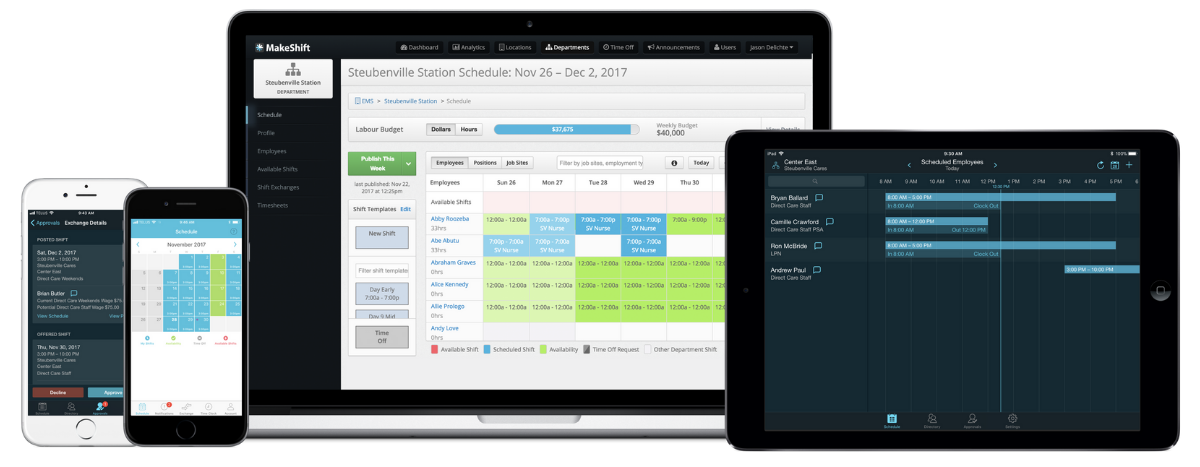In today's fast-paced and demanding work environment, many employees are feeling pressured to shoulder more responsibilities and work longer hours.
While hard work is virtuous, overworking employees is a growing problem that can lead to burnout, reduced productivity, and even serious health issues.
This shouldn't be the norm and there are ways to combat this culture of overwork.
In this article, we’ll discuss some tips and strategies to help you recognize and address overworked employees, promote a healthier work-life balance, and create a positive and productive work environment.
- What Is an Overworked Employee?
- Statistics on Overworked Employees In the U.S.
- 4 Warning Signs of Overworked Employees
- The Cost of Overworking Your Staff
- 5 Solutions to Combat the “Cult” of Overwork Culture
- How to Prevent Overworking Your Employees
- MakeShift’s Solution for Overworked Employees
What Is an Overworked Employee?
An overworked employee is someone who is shouldering excessive or prolonged job demands that exceed their physical, emotional, and cognitive abilities.
Overworked employees may feel they’re expected to work long hours, have unrealistic workloads, work in high-stress environments, or have limited control over their work tasks and schedules.
This can lead to physical, emotional, and mental exhaustion and impact their job performance, work-life balance, and overall well-being.
Statistics on Overworked Employees In the U.S.
The stats are in on the U.S. workforce, and the unfortunate takeaway is that we’re a nation of overworked employees.
Do we prioritize work over well-being?
While we can’t definitively answer that question, U.S. workers seem to be expected to work a significantly higher number of hours than other countries.
- 10.4% of American adults work 50+ hours per week on average — 49% higher than the average
- The U.S. is the only country in the Americas without a national paid parental leave benefit. The average is over 12 weeks of paid leave anywhere other than Europe and over 20 weeks in Europe.
- U.S. workers work an average of 1,791 hours per year versus an OECD country average of 1,716.
- 442 more hours per year than German workers
- 294 more hours per year than UK workers
- 301 more hours per year than French workers
- Nearly 65% of employees feel they're asked to do work outside of their job description or what they're being paid for — it’s called “Quiet Hiring”.
Wondering about the health effects of working years of long hours?
As you probably guessed, the impact is significant.

- People working 55 + hours each week have a 35% higher risk of stroke and a 17% higher risk of dying from heart disease.
- Between 2000 and 2016, the number of deaths from heart disease due to working long hours increased by 42%, and from stroke by 19%.
4 Warning Signs of Overworked Employees
It’s important to watch for these 4 signs that show you may have employees struggling from being overworked.
Being able to recognize the signs of an overworked employee is the 1st step in taking action to help your staff.
1. Physical Signs of Overworked Employees
Recognizing the physical signs of overworked employees is crucial for maintaining a healthy work environment.
If left unchecked, overwork can lead to burnout, which can cause long-term physical and mental health issues. By being attentive, you can help prevent burnout and ensure your team stays healthy, productive, and motivated.
Talk to your employees about these signs — encourage your staff to come to you if they’re regularly experiencing these symptoms.
- Fatigue and exhaustion
- Lack of sleep
- Increased illness and infections
- Chronic pain
- Weight gain or loss
2. Emotional Signs of Overworked Employees
It's important to communicate with your employees about the emotional symptoms that come from being overworked because they can seriously impact mental health.
When employees feel overwhelmed, stressed, or anxious, it can kill productivity and motivation. By addressing these issues and finding solutions together, you can create a happier and healthier workplace for everyone.
Address these symptoms with your staff and keep an eye out for them when they’re at work.
- Decreased motivation and enthusiasm
- Irritability and mood swings
- Anxiety and depression
- Lack of focus and concentration
- Poor decision-making skills
3. Behavioral Signs of Overworked Employees
Watching for behavioral symptoms while your staff is working will help you identify signs of any overworked employees.
By being aware of these warning signs, you can take proactive steps to support your team before burnout occurs.
If you notice any of these signs in an employee, check their work hours in the past month to see if they’ve been putting in excessive overtime.
- Increased absenteeism
- Decreased productivity
- Procrastination and missed deadlines
- Increased use of caffeine
- A change in overall attitude
4. Relational Signs of Overworked Employees
Watching how your employees relate to each other and customers is important for identifying and addressing an overworked team member.
When someone’s feeling overworked, they may be short-tempered or distant, which can mess with team dynamics and customer satisfaction.
By being observant of these changes and having an ongoing dialogue with your team, you can help prevent these issues from escalating and maintain a positive work vibe.
Watch for these signs and talk to the employee about what you’re observing.
- Decreased communication and collaboration with the team
- Poor interpersonal relationships
- Increased conflict with colleagues or superiors
- Lack of empathy and understanding towards others
- An overall negative attitude about their work and the team
The Cost of Overworking Your Staff
Overworking your employees can have a serious cost for both your business and your team.
Not only can it lead to decreased productivity, motivation, and revenue — it can also result in burnout, high turnover rates, and increased healthcare costs.
- Burnout costs companies $125 billion to $190 billion in healthcare costs each year.
- Businesses lose an estimated $300 billion annually due to absenteeism, reduced productivity, and turnover caused by job stress.

- Overworked employees are 2.6 times more likely to leave their job than employees with a healthy work-life balance.
- Work-related stress is the leading workplace health problem in the United States, and it's estimated to cost businesses $30 billion per year in lost workdays.
5 Solutions to Combat the “Cult” of Overwork Culture
Today's cult of overwork culture is booming. Many people feel pressure to work long hours, sacrifice their personal lives, and prioritize their jobs above all else to be considered a success.
You must find solutions to combat the overwork culture because it can have serious consequences on both individuals and society as a whole.
Promoting a healthier work-life balance and creating a culture that values well-being, helps prevent burnout, improves mental health, and increases overall productivity and happiness.
These 5 solutions focus on changing the vibe of your company culture to help support your staff’s well-being.
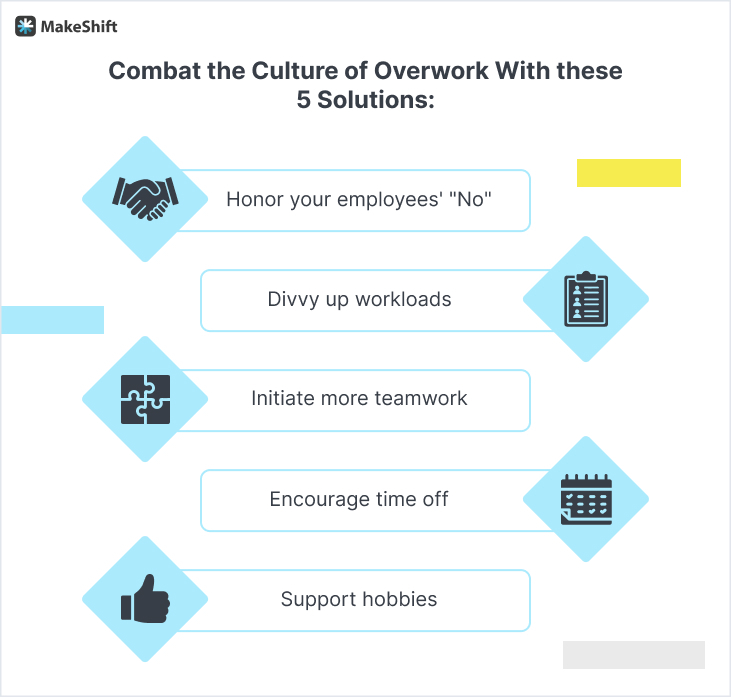
- Honor your employees’ “No” — Within reason, let your employee know it’s ok to say no to extra work or staying late. Letting your team know their well-being matters goes a long way in heading off burnout.
- Delegate tasks & divvy up workloads — Sometimes, overworked employees are simply being asked to do too much. By delegating tasks and evenly distributing workloads, you’ll reduce the burden on individual team members.
- Initiate more teamwork — Encouraging more teamwork and collaboration can help squash stress and boost motivation. By fostering a positive team environment, your employees will feel more supported and better equipped to handle challenges.
- Encourage your staff to take time off — Taking time off is crucial for preventing burnout, but many employees feel guilty or fearful of taking time away from work. As a manager, lead by example and encourage your team to take the time off they need to recharge.
- Support your staff taking up hobbies — Pursuing hobbies and other outside interests can be a great way for employees to unwind and reduce stress. Encouraging your team to pursue their passions outside of work can help them feel more fulfilled and prevent burnout.
How to Prevent Overworking Your Employees
Changing your company culture to focus on your staff’s well-being is a step in the right direction in helping your overworked employees.
The steps below go further in preventing you from overworking your employees in the future.
1. Establish Clear Expectations
Establishing clear expectations is crucial for preventing your employees from becoming overworked and for creating a healthy work environment.
Here are a few ways to do this:
- Set realistic workloads & deadlines — Set workloads and deadlines that are realistic and achievable based on the available time and resources. Overloading employees with too much work can quickly lead to burnout and decreased productivity.
- Communicate expectations clearly & regularly — Regularly communicating expectations with your employees can prevent misunderstandings and ensure everyone is on the same page. This includes outlining goals, priorities, and any changes to the workload or deadlines.
- Encourage open communication — When your employees feel comfortable expressing their concerns and needs to you, it can head off staff burnout. Encouraging open communication can also help identify potential issues before they become serious problems.
- Ensure employees understand their roles & responsibilities — When employees have a clear grasp of their roles and responsibilities, they’re better equipped to manage their workload and avoid overworking.
2. Provide Good Resources
Providing good resources helps your employees do their jobs effectively and avoid wearing themselves out through inefficient workflows.
Here's what you can do:
- Make necessary tools & resources available — Whether it's software, equipment, or office supplies, make sure your team has access to the tools they need to get their work done efficiently. Outdated or inadequate resources can lead to frustration and time wasted on workarounds.
- Provide training & professional development opportunities — Empower your employees to develop new skills and enhance their existing ones through training and professional development opportunities. This can boost their engagement at work and provide opportunities for growth.
The right resources can have a big impact on your employees and your business:
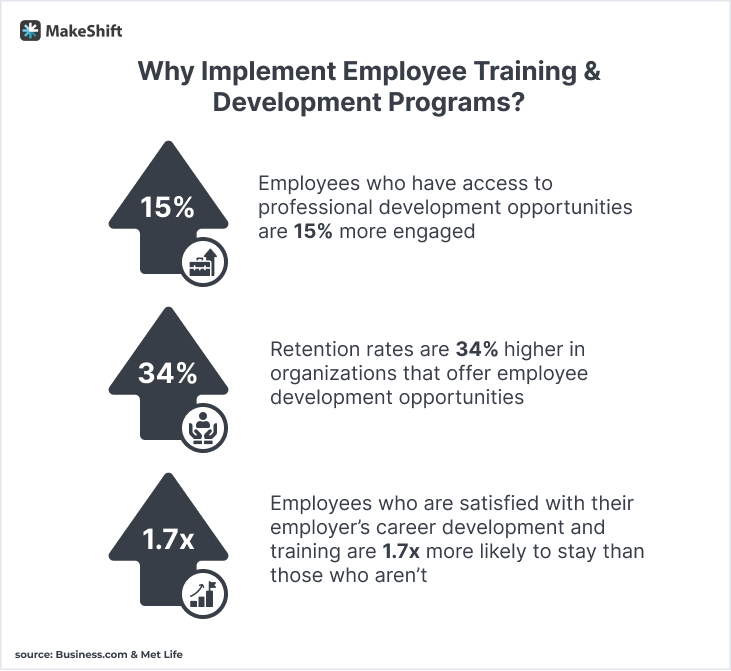
- Employees who have access to professional development opportunities are 15% more engaged.
- Retention rates are 34% higher among organizations that offer employee development opportunities.
- Employees who are satisfied with their employer’s career development and training are 1.7x more likely to stay than those who aren’t.
- Hire enough staff to evenly distribute workloads — Don't overload your team with too much work. Hire enough staff to distribute the workload evenly, so no one feels overwhelmed or overworked.
- Consider outsourcing or delegating tasks to other departments — If your team is still struggling with an excessive workload, consider outsourcing or delegating tasks to other departments or 3rd-party vendors. This can ease the burden on your team and free up time for more important tasks.
3. Encourage Work-Life Balance
Encouraging work-life balance is key to keeping your employees happy and healthy.
Here's how to promote it:
- Promote flexible work schedules & shift swaps — Give your team flexibility with their work schedules, so they can better balance their work and personal lives. Allow for shift swaps or work-from-home options, so they can attend to personal matters without sacrificing work obligations.
- Create a positive workplace culture that prioritizes work-life balance —Fostering a positive workplace culture helps promote work-life balance. Encourage healthy habits and activities like exercise, meditation, or wellness programs.
- Set an example by maintaining a healthy work-life balance — As a manager, lead by example with your own work-life balance. Make sure you're taking time off and managing your workload effectively. This sets the tone for the rest of your team and helps them feel more comfortable taking time off themselves.
4. Recognize and Address Burnout Early
Recognizing and addressing burnout early helps keep your team motivated and healthy.
Here's what you can do:
- Train managers to recognize burnout —Train your managers to recognize these signs so they can address burnout early and prevent it from spreading.
- Overly cynical or critical
- Lack of focus
- Lack of motivation
- Fatigue
- Dissatisfaction
- Increased last-minute absenteeism
- Provide support & resources to employees experiencing burnout — If your employee is experiencing burnout, get them support and resources. This could include counseling services, flexible work arrangements, or a temporary reduction in workload.
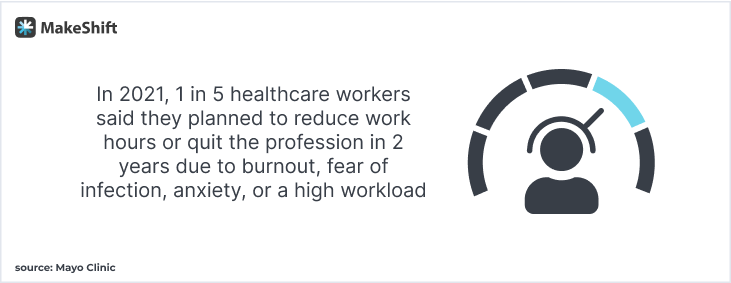
A Mayo Clinic 2021 study found that 1 in 5 healthcare workers said they planned to reduce work hours or quit the profession in 2 years due to burnout, fear of infection, anxiety, or a high workload.
- Create a workplace culture that values self-care & stress management — Encourage self-care and stress management by offering wellness programs, promoting healthy habits, and encouraging employees to take breaks and prioritize their mental health. This helps prevent burnout from happening in the first place.
5. Implement Tech That Increases Oversight and Your Employee’s Voice
Implementing technology that increases oversight and employee involvement can help improve your workplace.
Scheduling software is a great place to start to help alleviate overworked employees with smarter scheduling.
Here’s how to utilize tech for your scheduling process:
- Use intuitive scheduling software — Interactive scheduling software can make scheduling more efficient and optimize your workforce. Plus, it can boost employee engagement and satisfaction.
- Keep up with staff scheduling software trends — Keeping up with the latest trends can help you optimize your scheduling processes and utilize the latest cutting-edge technology.
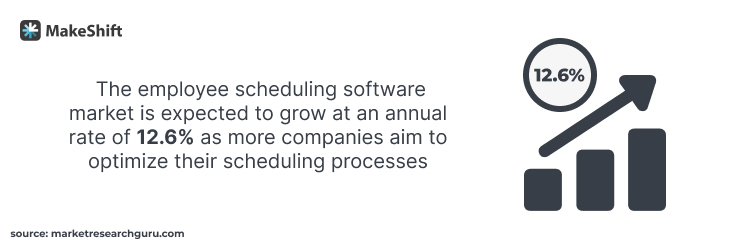
- Use software with fatigue rules — Some scheduling software offer fatigue rules that help you manage excessive overtime automatically. This can help prevent burnout and keep your employees healthy and productive.
MakeShift’s Solution for Overworked Employees
MakeShift was developed to address the frustrated, overworked employee by revolutionizing the scheduling process.
MakeShift’s people-first approach helps get a handle on managing your overworked employees through intuitive scheduling.
Our staff scheduling software provides these solutions to address (& prevent) overworked employees:
1. Fair Workload Distribution
MakeShift Scheduling allows you to create and manage work schedules easily and efficiently.
Managers can distribute workloads more evenly across their workforce, ensuring that no employee is overburdened with excessive work.
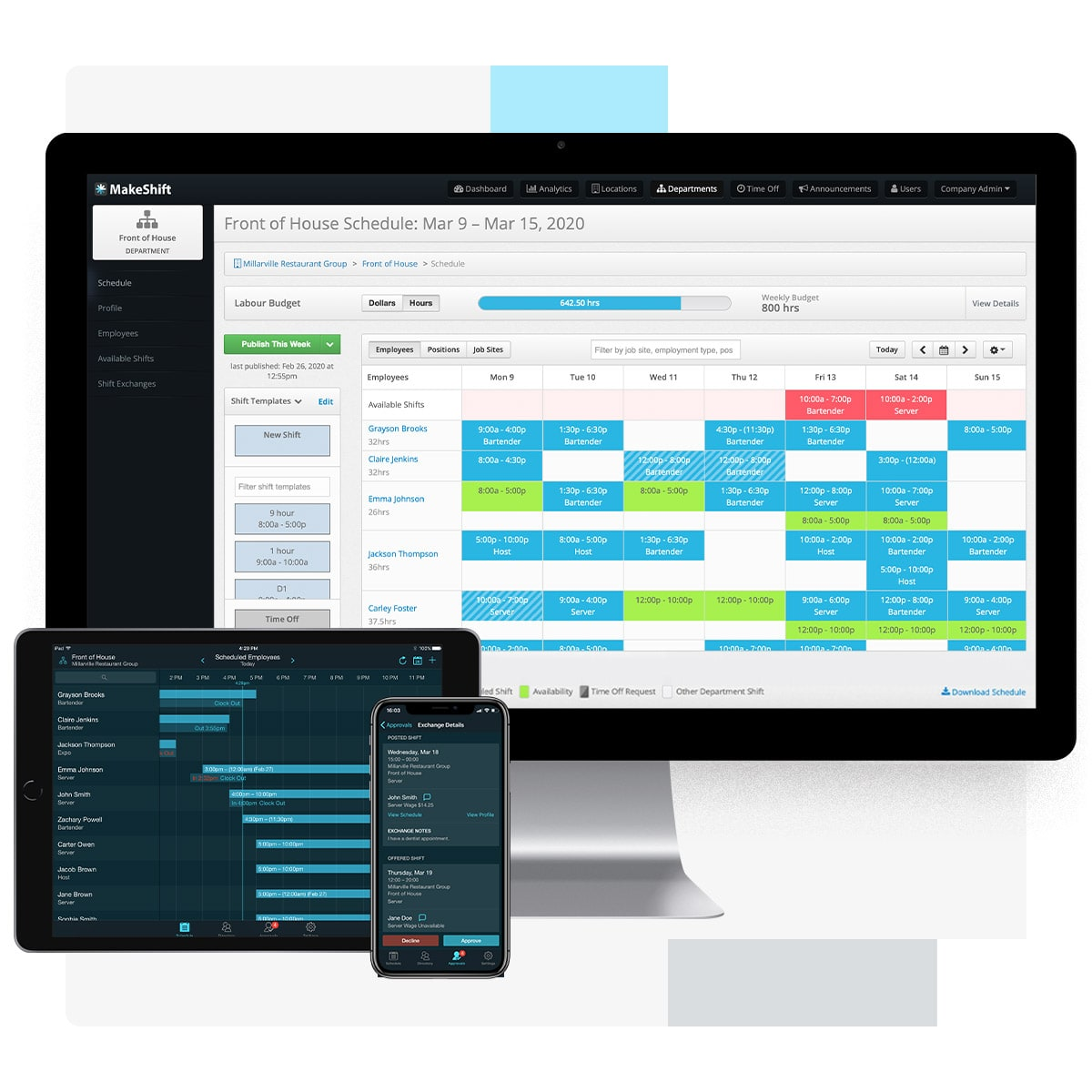
By creating fair and balanced schedules, MakeShift Scheduling can help prevent unknowingly overworking your employees.
2. Real-Time Schedule Adjustments
MakeShift Scheduling allows you to make real-time schedule adjustments based on business and employee needs.
This means that if unexpected events occur, such as an increase in customer demand or a shortage of staff, managers can quickly adjust schedules to ensure that workloads are distributed evenly.

This helps prevent overworking employees by ensuring that they’re not expected to take on more work than they can handle.
3. Empowerment of Employees
MakeShift Scheduling allows your employees to manage their own schedules through a mobile app.
They can see their schedule, set availability, request time off, and offer to pick up shifts.
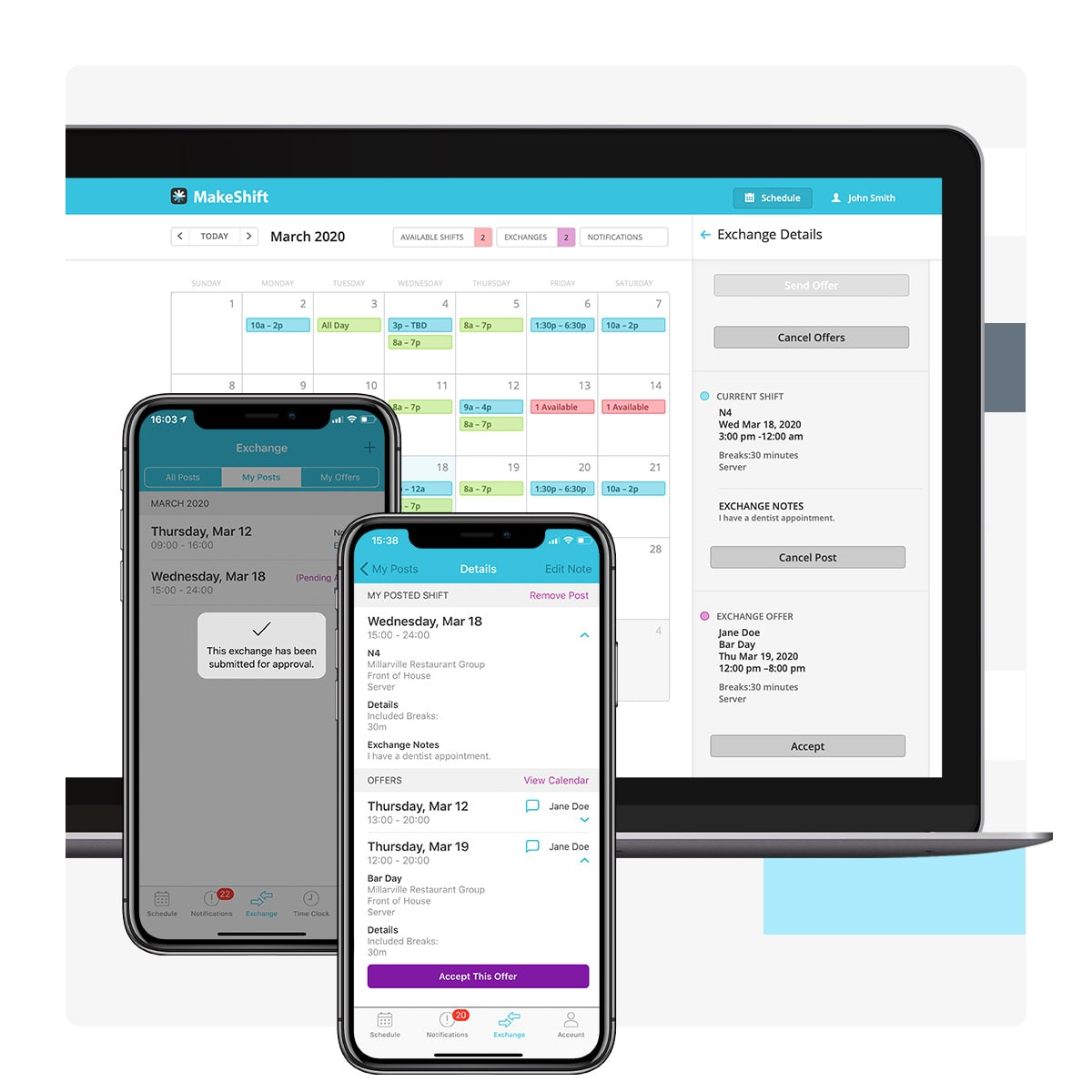
This gives them more control over their work schedule, allowing them to balance their work and personal lives better.
When employees have more control over their schedules, they are less likely to become overworked.
4. Improved Communication
MakeShift Scheduling provides a platform for managers and employees to communicate easily and effectively.
Employees can use the app to communicate their availability, request time off, and offer to pick up shifts.

Managers can use the app to send notifications, reminders, and make quick approvals.
Improved communication helps managers to keep track of workload and prevent overworking employees.
Overworking Employees Shouldn’t Be the Norm
With today’s labor shortage, companies are requiring more of their existing staff. And many workers are stepping up to shoulder more responsibilities and work extra hours.
However, exhausted, overworked employees shouldn’t be the norm in today’s work culture.
Be proactive by providing great solutions to help your employees maintain their well-being and their productivity.
Smarter scheduling is a way to identify and prevent overworked employees. Schedule a free demo today to see how we can help.




